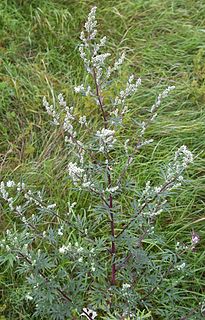
Senecio vulgaris, often known by the common names groundsel and old-man-in-the-spring, is a flowering plant in the daisy family Asteraceae. It is an annual herb, native to Europe and widely naturalised as a ruderal species in suitable disturbed habitats worldwide.

The common starling or European starling, also known simply as the starling in the British Isles, is a medium-sized passerine bird in the starling family, Sturnidae. It is about 20 cm (8 in) long and has glossy black plumage with a metallic sheen, which is speckled with white at some times of year. The legs are pink and the bill is black in winter and yellow in summer; young birds have browner plumage than the adults. It is a noisy bird, especially in communal roosts and other gregarious situations, with an unmusical but varied song. Its gift for mimicry has been noted in literature including the Mabinogion and the works of Pliny the Elder and William Shakespeare.

The beetroot is the taproot portion of a beet plant, usually known in Canada and the USA as beets while the vegetable is referred to as beetroot in British English, and also known as the table beet, garden beet, red beet, dinner beet or golden beet. It is one of several cultivated varieties of Beta vulgaris grown for their edible taproots and leaves ; they have been classified as B. vulgaris subsp. vulgaris Conditiva Group.

Phaseolus vulgaris, also known as the common bean and French bean, is a herbaceous annual plant grown worldwide for its edible dry seeds or unripe fruit. The main categories of common beans, on the basis of use, are dry beans, snap beans and shell (shelled) beans. Its leaf is also occasionally used as a vegetable and the straw as fodder. Its botanical classification, along with other Phaseolus species, is as a member of the legume family Fabaceae. Like most members of this family, common beans acquire the nitrogen they require through an association with rhizobia, which are nitrogen-fixing bacteria.

Artemisia vulgaris, the common mugwort, is a species of flowering plant in the daisy family Asteraceae. It is one of several species in the genus Artemisia commonly known as mugwort, although Artemisia vulgaris is the species most often called mugwort. It is also occasionally known as riverside wormwood, felon herb, chrysanthemum weed, wild wormwood, old Uncle Henry, sailor's tobacco, naughty man, old man or St. John's plant. Mugworts have been used medicinally and as culinary herbs.

Calluna vulgaris, common heather, ling, or simply heather, is the sole species in the genus Calluna in the flowering plant family Ericaceae. It is a low-growing evergreen shrub growing to 20 to 50 centimetres tall, or rarely to 1 metre (39 in) and taller, and is found widely in Europe and Asia Minor on acidic soils in open sunny situations and in moderate shade. It is the dominant plant in most heathland and moorland in Europe, and in some bog vegetation and acidic pine and oak woodland. It is tolerant of grazing and regenerates following occasional burning, and is often managed in nature reserves and grouse moors by sheep or cattle grazing, and also by light burning.
Backcrossing is a crossing of a hybrid with one of its parents or an individual genetically similar to its parent, in order to achieve offspring with a genetic identity which is closer to that of the parent. It is used in horticulture, animal breeding and in production of gene knockout organisms.

Berberis, commonly known as barberry, is a large genus of deciduous and evergreen shrubs from 1–5 m (3.3–16.4 ft) tall, found throughout temperate and subtropical regions of the world. Species diversity is greatest in South America and Asia; Europe, Africa and North America have native species as well. The best-known Berberis species is the European barberry, Berberis vulgaris, which is common in Europe, North Africa, the Middle East, and central Asia, and has been widely introduced in North America. Many of the species have spines on the shoots and all along the margins of the leaves.

Green beans are the unripe, young fruit of various cultivars of the common bean. Immature or young pods of the runner bean, yardlong bean, and hyacinth bean are used in a similar way. Green beans are known by many common names, including French beans, string beans, snap beans, snaps, and the French name haricot vert. They are also known as Baguio beans in Philippine English, to distinguish them from yardlong beans. Other locals in the vegetable farming regions of the Philippines refer these as "habitchuelas". It is commonly grown in the northern highlands of Benguet, Mountain Province and Nueva Vizcaya, and other mid-elevation areas in the country like Bukidnon, Quezon and Laguna.

Primula vulgaris, the common primrose, is a species of flowering plant in the family Primulaceae, native to western and southern Europe, northwest Africa, and parts of southwest Asia. The common name is primrose, or occasionally common primrose or English primrose to distinguish it from other Primula species also called primroses. None of these are closely related to the evening primroses.

Syringa vulgaris is a species of flowering plant in the olive family Oleaceae, native to the Balkan Peninsula, where it grows on rocky hills. Grown for its scented purple flowers in spring, this large shrub or small tree is widely cultivated and has been naturalized in parts of Europe and North America. It is not regarded as an aggressive species, found in the wild in widely scattered sites, usually in the vicinity of past or present human habitations.

Pulsatilla vulgaris, the pasqueflower, is a species of flowering plant belonging to the buttercup family (Ranunculaceae), found locally on calcareous grassland in Europe. It was considered part of the genus Anemone, to which it is closely related.

Berberis vulgaris, also known as common barberry, European barberry or simply barberry, is a shrub in the genus Berberis. It produces edible but sharply acidic berries, which people in many countries eat as a tart and refreshing fruit.

Pemphigus vulgaris is a rare chronic blistering skin disease and the most common form of pemphigus. Pemphigus was derived from the Greek word pemphix, meaning blister. It is classified as a type II hypersensitivity reaction in which antibodies are formed against desmosomes, components of the skin that function to keep certain layers of skin bound to each other. As desmosomes are attacked, the layers of skin separate and the clinical picture resembles a blister. These blisters are due to acantholysis, or breaking apart of intercellular connections through an autoantibody-mediated response. Over time the condition inevitably progresses without treatment: lesions increase in size and distribution throughout the body, behaving physiologically like a severe burn.

Era Vulgaris is the fifth studio album by American rock band Queens of the Stone Age. Recorded from July 2006 to April 2007, it was released on June 11, 2007 in the United Kingdom and June 12 in the United States, having been released on June 8 in other countries. The single "Sick, Sick, Sick" was released in May, followed by second single "3's & 7's" in early June, and third single "Make It wit Chu" in October. The album debuted at No. 14 on the U.S. Billboard 200 charts, selling 52,000 copies in its first week. It reached top ten positions in other countries, such as No. 7 in the UK, No. 5 in Canada, and No. 4 in Australia. is the band's last album with Interscope Records
Hecajapyx is a genus of diplurans in the family Japygidae.
Euseius vulgaris is a species of mite in the family Phytoseiidae.

Sarecycline is a narrow-spectrum tetracycline-derived antibiotic. It is specifically designed for the treatment of acne, and was approved by the FDA in October 2018 for the treatment of inflammatory lesions of non-nodular moderate to severe acne vulgaris in patients 9 years of age and older. Two randomized and well-controlled clinical trials reported efficacy data on both facial and truncal acne. Efficacy was assessed in a total of 2002 subjects 9 years of age and older. Unlike other tetracycline-class antibiotics, sarecycline has a long C7 moiety that extends into and directly interact with the bacterial messenger RNA (mRNA). The spectrum of activity is limited to clinically relevant Gram-positive bacteria, mainly Cutibacterium acnes, with little or no activity against Gram-negative bacterial microflora commonly found in the human gastrointestinal tract. Sarecycline has not been tested in spirochetes.

Clascoterone, sold under the brand name Winlevi, is an antiandrogen medication which is used topically in the treatment of acne. It is also under development in a higher concentration for the treatment of androgen-dependent scalp hair loss, under the brand name Breezula. The medication is used as a cream by application to the skin, for instance the face and scalp.
Hecajapyx bucketti is a species of forcepstail in the family Japygidae. It is found in North America.















